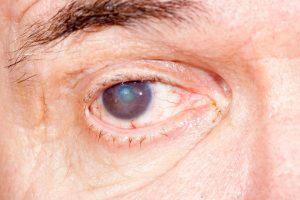
Oxidative stress is a chemical reaction that occurs when cells consume oxygen and other fuels as a means to produce energy. This is a natural process associated with aging and is often tied to age-related problems.
Cells found in the eye lens are mainly made up of water and proteins. They typically lack organelles, which are tiny ‘organs’ found in other cells. This unusual cellular makeup allows for the transparency of the eye lens, enabling it to transmit light and focus it on the retina. Under the impact of oxidative stress, the proteins of the lens cells start clumping together, forming a cataract.
The study revealed that UV light triggers lens protein damage in the same way oxygen does in the process of oxidative stress.
Senior author Ram Nagaraj said, “UV light has long been suspected to have a role in cataract formation, but the mechanism has not been clear. Our study shows how UV light could promote cataract development, and reiterates the importance of wearing sunglasses to protect your eyes [from] the sun’s harmful rays.”
Natural antioxidants were found ineffective in preventing cataracts caused by UV light. Alternative studies have shown mixed results with regards to antioxidant supplementation as a means to prevent or slow down cataract formation.
Houmam Araj of the National Eye Institute said, “When do these mechanisms work in the lens and when do they fail? Answering those questions might lead to drug treatments for preventing cataract, and perhaps even skin cancer. The eye and lens provide a useful, accessible system to study general countermeasures the body might have for defending itself against UV radiation.”
Cataract treatment, prevention, and home remedies
Cataracts are easily diagnosed with an eye exam where your doctor will dilate your pupils to properly examine your eye. Based on the condition of your eyes and the progression of cataracts, your doctor will choose the appropriate mode of treatment.
Treatment options for cataracts include prescription glasses or contacts. If corrective eyewear doesn’t improve your vision, you may be a candidate for cataract surgery.
Cataract surgery is quite common in the U.S., with 1.5 million surgeries taking place each year. The surgery involves removing the cloudy lens and replacing it with a clear artificial one. Ninety percent of patients who undergo cataract surgery experience vision improvement.
If you’re looking for a cure for eye cataract or the natural way to manage your cataract, what you really need to look into is prevention. To date, the only cure for eye cataract is surgery, but there are lifestyle changes you can implement to prevent cataracts and protect your vision. Follow these easy tips:
- Improve the lighting in your home with more lighting and brighter lamps.
- Limit your night driving.
- When you go outside in daytime, wear sunglasses or a broad-brimmed hat to reduce glare.
- Avoid sunlamps and tanning booths.
- Get your eyes checked once a year (more often, if you’ve noticed problems).
- Make sure your eyeglasses or contact lenses are the most accurate prescription.
- Use a magnifying glass to read.
- Keep diabetes under control with diet, exercise, and medication.
- Quit smoking.
The best home remedies for cataracts start with food for eyes. The nutrients we take in help protect our cells from damage. Carotenoids, the pigments that occur naturally in algae and plants, are at the cornerstone of nutrition for cataract prevention.
Leafy greens, bell peppers, and carrots. Eat more spinach, kale, and Swiss chard – all rich in the carotenoid, lutein. Another top plant source is red bell pepper. Red peppers also provide good-for-eyes vitamin C. Carrots and other orange-colored fruits and vegetables are also top choices for eyes: Beta-carotene, a type of vitamin A that gives these foods their orange hue, is a vision booster. It promotes the optimal functioning of the retina and other parts of the eye.
Fatty fish, especially salmon (wild-caught is best). Fish has essential fatty acids that your body and eyes depend on. DHA (docosahexaenoic acid) is the primary omega-3 fatty acid found in these fish – and a nutrient that concentrates in the retina.
Eggs. Eggs contain the omega-3 fatty acid DHA and are the most readily available source of carotenoids, which are more easily absorbed by the body from eggs than from vegetables because of the fats the eggs contain.
Nuts and seeds. Vitamin E helps protect the cells in our eyes from free radicals, and nuts and seeds are packed with vitamin E. You don’t need a lot. One ounce of sunflower seeds or almonds will give you more than a third of your recommended daily dose of vitamin E. Walnuts are ranked as one of the best nut sources of omega-3s. Pistachios are a close second. In small amounts, they can be converted to EPA (eicosapentaenoic acid), another omega-3 fatty acid used by the eyes, along with DHA.
Fresh fruits, especially avocados. Avocados are incredibly nutrient rich. They’re a great source of carotenoids and other important eye nutrients such as beta-carotene and vitamins C, E, and B6.